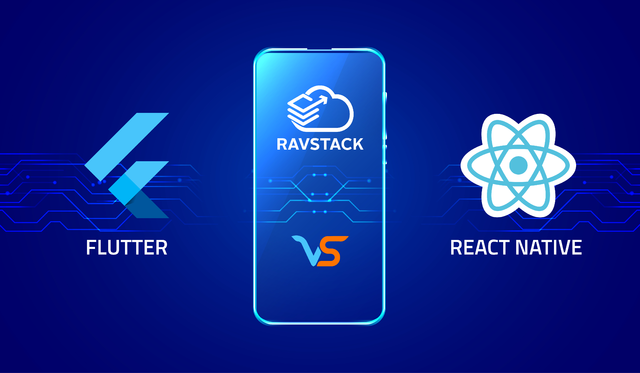As more and more people are accepting modernized technology, the demand for mobile apps has increased to a large scale. To walk parallelly with the growing needs of the clients and businesses, the constant inflow of the updated technology, frameworks, and platforms becomes a must.
Nowadays, cross-platform app development is becoming very popular among start-ups. With the help of this platform, developers can build various interactive apps.
Therefore, the two most popular mobile app development frameworks Flutter vs React Native are creating the buzz and fighting to prove itself to be the host of the cross-platform mobile app development. React Native vs Flutter was the most popular topic in 2018 and 2019.
React Native was introduced by Facebook, and in very less time, it became very popular and provides many benefits to organizations. However, Flutter, introduced by Google, is a newbie in the mobile application industry. Still, it creates high performing native applications and helps full stack developers to build cross-platform apps with ease.
We are here to provide a comparison of Flutter vs React Native performance, which is done based on various parameters. This comparison chart will provide some help to the start-ups as they can easily identify which framework will be the best suited for their mobile app development.
User Interface
While considering the user interface of an app and creating the block component, you will find a big difference between React Native and Flutter. React Native is based on native components, whereas Flutter works perfectly with the proprietary widget sets, owner widgets are the best for getting a customized UI design that will provide dynamism and native support.
React Native is the most dynamic framework that provides a much better user experience as a comparison with Flutter. Currently, there are three main UI libraries:-
- React Native elements
- Shoutem UI components
- Native base components
Native appearance
Flutter has greater native appearance because of the access to device core functionalities whereas React Native has lower because it is dependent on third-party APIs.
Programming language
React Native utilizes JavaScript to build cross-platform apps. JavaScript is a very popular language in the industry at the moment. It is commonly utilized with React and other popular frameworks.
Flutter utilizes Dart programming language which was invented by Google in 2011 and is rarely used by programmers. Dart syntax is very simple to understand for JavaScript or Java developers as it supports most of the object-oriented concepts.
Technical architecture
React Native uses the Flux architecture from Facebook. In short, it uses the JavaScript bridge to communicate with the native modules.
Flutter utilizes the Dart framework which includes the inbuilt components and usually does not require the bridge to communicate with the native modules. Dart has so many frameworks, like Cupertino, and Material Design, which provide all the required technologies needed to build mobile apps.
Development time
Many mobile app development companies that have emerged these days have proved their expertise in the timely delivery of projects, and React Native has remained one of the best partners for all these organizations. This framework reduces the development time of projects and adds more to the user interface.
In the comparison of Flutter vs React Native, Flutter is a new framework and requires considerable time to build projects. React Native has ready-to-use components that reduce the time of mobile application development without creating so many problems for app developers. Flutter also provides high-quality usability, but the framework for mobile application development needs to get more recognition over React Native.
Evaluate performance
Flutter vs React Native performance mapping is the right option to know which framework is best for mobile app development. The reason why Flutter vs React Native stays more ideal of other frameworks is due to the Dart framework. Additionally, the JavaScript layer provides them a connection with native components easily.
React Native has excellent support from communities; however, developers are aware of the issues they face when it comes to creating hybrid applications. However, native apps are comprehensive frameworks for these requirements. As per the framework, the developers will not face any problem while building an application in a native environment.
Developers sometimes face problems while working on React Native hybrid application architecture. Whereas Flutter makes the process easier for developers as they can reuse the existing code. The C ++ engine works efficiently and supports the language; hence Flutter gains appreciation here.
DevOps and CI/CD support
React Native doesn’t have any official documentation on setting up CI/CD whereas Flutter’s rich command-line interface can easily set up CI/CD.
Popular apps made with Flutter
- Xianyu app by Alibaba
- Google Ads app
- Hamilton app
- Topline app by Abbey Road Studios
- JD Finance app
Popular apps made with React Native
- Facebook
- Fb Ads
- Instagram
- Pinterest
- Skype
- Tesla
- Bloomberg
- Wix.com
Stability
Stability is one of the important factors for companies that expect a proficient mobile app. When we differentiate between React Native and Flutter, the competition is quite tough. Flutter beta 2 version provides some advanced features for the RavStack developers. Broad community support for React Native because of its consistency and reliability, whereas Flutter, is still struggling to make a mark. Hence React Native won this fight.
Hot reload
Both Flutter and React Native support hot reloading which is spreading quickly compared to how true native apps recompile in Android Studio and XCode. If your app encounters an error, you can quickly resolve the error and then continue on as if the problem never happened.
Flutter is the winner here because of faster hot reloading than React Native.
Appraise code structure
When it comes to the coding structure, it is very important to consider frameworks that fulfill your requirements. Flutter enables programmers to code everything from one central location and provides access to all the features you need.
Clientele
React Native is so popular these days. It was, and it is among the most efficient mobile app development framework for the RavStack developers. It has all the important features to carry out the project of any size. This framework includes some big project names like Facebook, Airbnb, Instagram, Skype, Walmart, etc.
Flutter, which is a newcomer, still struggling to make its presence felt in the industry. This framework will take some time to create a base and be recognized in the market. Currently, only one Hamilton application is what you have in store to show, and with time this framework will surely add prominent brands to its list.
Future of Flutter and React Native
More and more app development companies are attracted to the Flutter framework. After all, we’re witnessing continuous improvements in the Flutter SDK as Google continues to refine its tool. What’s more, we can expect that soon Flutter will help us to create not only mobile applications but also web and desktop applications.
Putting it all together – and given leading organizations like Alibaba are already using Flutter – the future looks bright for the framework.
On the other hand, for React Native, Facebook is currently focusing on a big-scale re-architecture of the technology.
RavStack team is doing its level best to improve support for both React Native users and the large community.
RavStack for React Native and Flutter app development
RavStack being the best Flutter and React Native development company, serves you with world-renowned development services. Our team of developers empowers your business with proficient iOS and Android apps in accordance with the particular business development project undertaken.
We have a team of highly skilled developers possessing an exceptional combination of creativity and skills that make us deliver unparalleled services of React Native and Flutter app development.
Get in touch with our expert developers & consultants
We'll get back to you within 24 hours
Talk to our expert

 September 16, 2020
September 16, 2020
 11 mins read
11 mins read
 +1 415 800 4089
+1 415 800 4089 info@ravtsack.com
info@ravtsack.com






 March 11, 2020
March 11, 2020 8 mins read
8 mins read



)




